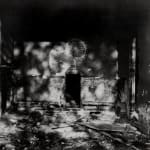Paul Nash
Demolition Landscape, 1934
Vintage Gelatin Silver Print
14.61 x 25.4 cms
5 12/16 x 10 ins
12604
Further images
Provenance
Eileen Agar, the eminent British artist and intimate of NashPaul Conran
Exhibitions
Lee Miller and Surrealism in Britain, Hepworth Wakefield, 2018 (This print)Literature
"Unseen Landscapes", Country Life, vol.LXXIII, 1938, pp.526-7.Paul Nash. Fertile Image, Faber and Faber, 1951 (Illustrated number 51) (illustrated as part of a photomontage entitled Empty Room (1937)
Andrew Causey, Paul Nash's photographs. Document and Image, Tate Gallery, 1973 (illustrated full page as plate 35 and catalogued p.120)
The negative for this work is in the Tate Archive. An exceptionally rare vintage print. Paul Nash was one of the most important British painters, draftsmen and printmakers of the...
The negative for this work is in the Tate Archive.
An exceptionally rare vintage print.
Paul Nash was one of the most important British painters, draftsmen and printmakers of the first half of the twentieth century. However by the mid 1930s he had become increasingly engaged with photography and was gaining great acclaim in this medium. Indeed such was the praise that Nash wrote in July 1934: "My reputation as a photographer is growing alarmingly. I am pretty certain that it will eclipse mine as a painter unless I take a firm line" (letter to Ruth Clark, July 1934). An essay by the prestigious art writer Raymond Mortimer was about to be published on Nash's photographs and recognition was growing. (Raymond Mortimer, "Nature Immitates Art", Architecture Review, January 1935).
This photograph is reproduced alongside paintings and other photographs by Nash in his illustrated essay, "Unseen Landscapes", for Country Life magazine in 1938. As the largest picture reproduced, in any medium, its scale indicates the importance that Nash assigned the picture and indeed to photography.
Nash titles it "Demolition landscape" and provides the caption "Conventionally sinister ... a room in a partially demolished house traversed by sun and moon as in a wood."
In the body of the text Nash elaborates on these qualities. Writing of "fortuitous affairs of a conventionally sinister complexion" he describes the photograph as showing "the room of a partially demolished house, where the front wall has been pulled down, so that now the sun and moon traverse the floor and walls as in a wood, and the dilapidated uprights and broken sections of door-frames, obscured by shadows or mutilated by shafts of light, take on the semblance of tree forms: the sentinels, perhaps, of a forest land"
An exceptionally rare vintage print.
Paul Nash was one of the most important British painters, draftsmen and printmakers of the first half of the twentieth century. However by the mid 1930s he had become increasingly engaged with photography and was gaining great acclaim in this medium. Indeed such was the praise that Nash wrote in July 1934: "My reputation as a photographer is growing alarmingly. I am pretty certain that it will eclipse mine as a painter unless I take a firm line" (letter to Ruth Clark, July 1934). An essay by the prestigious art writer Raymond Mortimer was about to be published on Nash's photographs and recognition was growing. (Raymond Mortimer, "Nature Immitates Art", Architecture Review, January 1935).
This photograph is reproduced alongside paintings and other photographs by Nash in his illustrated essay, "Unseen Landscapes", for Country Life magazine in 1938. As the largest picture reproduced, in any medium, its scale indicates the importance that Nash assigned the picture and indeed to photography.
Nash titles it "Demolition landscape" and provides the caption "Conventionally sinister ... a room in a partially demolished house traversed by sun and moon as in a wood."
In the body of the text Nash elaborates on these qualities. Writing of "fortuitous affairs of a conventionally sinister complexion" he describes the photograph as showing "the room of a partially demolished house, where the front wall has been pulled down, so that now the sun and moon traverse the floor and walls as in a wood, and the dilapidated uprights and broken sections of door-frames, obscured by shadows or mutilated by shafts of light, take on the semblance of tree forms: the sentinels, perhaps, of a forest land"





